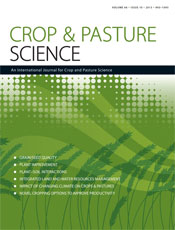Crop and Pasture Science
Volume 66
Number 10 2015
RESEARCH FRONT: Sustainable Water Use for Securing Food Production in the Mediterranean Region under Changing Climate
Irrigation and evapotranspiration, grain yield, aboveground biomass yield and harvest index were evaluated under fresh and saline water regimes. Different parameters, such as water productivity and irrigation water productivity, yield components, leaf area index and plant height, were studied to assess quinoa’s growth and yield. Grain yields were slightly reduced by irrigation water salinity compared with fresh water irrigation. Results showed that quinoa can be irrigated with saline water with EC level up to 30 dS m–1 with acceptable yields in the semi-arid and arid regions of the Mediterranean Basin.
This research aims to quantify the responses of drought-tolerant genotypes of chickpea to water availability under three irrigation regimes. Sixteen genotypes of chickpea were tested and ten genotypes performed better under 30% of and full supplemental irrigation. Three genotypes are recommended for the national programs of Mediterranean countries as being drought-tolerant and especially responsive to water.
This article contains a brief introduction on the status of drought conditions affecting the crops, the purpose of this research. It contains also the materials used, experimental design adopted, morphological and physiological traits measured and statistical analysis used. Results were presented in narrative way and in tables and graphs; those results were discussed. A list of references has been also presented.
The main concern of durum wheat breeders in Mediterranean environments is the significant yield losses from lack of rainfall during spring. In this study, genotypic variation in morphological, physiological and yield responses to pre-anthesis water-deficit stress was investigated by screening 20 durum wheat genotypes. Those tolerant to water-deficit stress showed superior performance in physiological traits such as chlorophyll content, leaf water potential and relative water content, which may be used as indicators of water-deficit stress tolerance and high yield potential in rainfed areas.
White clover germplasm exhibiting viral-coat-protein-mediated resistance to AMV and non-transgenic resistance to ClYVV has been developed. This report describes PCR-based assays for detecting the transgenes associated with the H6 transformation event in seeds, fresh leaves, air-dried leaves and mixtures of air-dried herbage of white clover and perennial ryegrass (hay).
Infection of ryegrass with Epichloë endophytes alters the rhizosphere metabolome, particularly n-alkane hydrocarbons. This is associated with shifts in the community bacterial and fungal community composition. There is potential to use specific endophyte-host interactions to alter the root microbiome for desired production or environmental outcomes.
An integrated process for discovery of novel endophytes based on exploitation of genotypic information has been designed and implemented. Genetic and chemotypic diversity analysis identified candidate strains, which were further characterised using a novel inoculation method that allows isogenic comparisons with respect to both host and endophyte genotype. Three prioritised candidates with desirable alkaloid profiles were obtained, one of which belongs to a putative novel taxon distinct from previously known groupings.
The timing of grazing in relation to patterns of depletion and replenishment of carbohydrate and nitrogen reserves can have implications for plant growth. This study aimed to characterise these patterns in vegetative chicory and plantain during summer and determine effects on plant growth. Reductions in herbage production occurred if swards of chicory or plantain were defoliated during the period of non-structural carbohydrate depletion or early stages of replenishment.
Random surveys conducted in Western Australia have shown that herbicide resistance in major crop weeds is common and increasing. The latest survey on resistance in Raphanus raphanistrum revealed that 84% of populations were resistant to the ALS-inhibiting herbicides, 76% were resistant to synthetic auxins, and 49% to PDS inhibitors. Resistance in Raphanus has increased over the 12 year survey period and a wide range of management tools are needed to control this species.
Two types of Smart irrigation controllers (SICs) based on evapotranspiration (ET) for scheduling irrigation water are studded under Saudi Arabia’s conditions. The purpose of this study is to evaluate the effectiveness of Hunter Pro-C and SmartLine SL 1600 devices on irrigation amount applied. The data analysis indicates that the Hunter Pro-C system saves water and produces a greater yield with the highest irrigation water use efficiency for subsurface irrigation.




